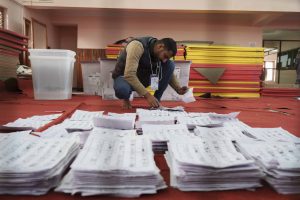The Nepali Congress (NC), which heads Nepal’s ruling coalition, has emerged as the single largest party in the parliamentary elections held on November 20. It is followed by the Communist Party of Nepal-United Marxist Leninist (CPN-UML), the main opposition party.
While the CPN-UML received marginally more votes than the NC under the proportional representation (PR) system (where voters cast a ballot for parties), the NC’s stronger showing under the first-past-the-post (FPTP) system put it ahead in the race to form Nepal’s next government. Most of the votes have been counted, but the total number of seats won by each party will take a few more days to be tallied. Meanwhile, leaders are engaging in hectic meetings, each seeking to corner a share in the next government.
In the run-up to the voting, analysts had described this election as a defining moment in Nepali politics. Voter frustration with the establishment’s inability to deliver economic growth and good governance was running high. The victory of a few young candidates in local elections held in May indicated that young, independent, and non-political candidates can take on and win big against the traditional political elite.
However, results from the parliamentary election indicate that this was an incrementally progressive election, but not transformational. The three major establishment parties came on top. The NC and the CPN-UML were followed by the Pushpa Kamal Dahal-led Communist Party of Nepal-Maoist Center (CPN-MC) in third place. The National Independent Party (NIP), a party registered barely a few months before the election, came in fourth.
Yet this election represented a break from the past; it displayed some new facets. First, voters unambiguously expressed frustration at the establishment. Six current ministers and 60 former parliamentarians lost their bids to return to parliament. Though the three major parties avoided the worst outcome, many of their senior leaders failed to win their seats.
Second, the NIP reaped the benefits of voter frustration and has emerged as a significant force in national politics. Voters exercised their franchise in favor of establishment candidates in the FPTP but used their PR vote in favor of the NIP. The NIP apparently chipped away votes from the three major establishment parties. Each of those three parties lost about 3 percentage points in vote share compared to 2017. The NIP has received 11 percent of the votes.
Third, people’s frustration also manifested at the regional level. A new regional party led by C.K. Raut disrupted the established order in Madhes province in southern Nepal in national and provincial elections.
The election also marks a comeback of social and political conservatism in Nepali politics. The Rashtriya Prajatantra Party (RPP), a monarchist and Hindu-nationalist party, won seven seats and almost 6 percent of the votes (in the 2017 election, it won one seat and 2 percent of the votes). A liberal agenda has dominated Nepali politics since 2006.
No party or coalition has received a clear mandate. At least three parties must cobble together a coalition to form a government unless the two main rivals, NC and CPN (UML) come together. This will likely create more instability and horse-trading among parliamentarians and parties. The pre-poll alliances were bereft of any ideology. The lust for power would only intensify in such a hung parliament. Hence, there will be more instability. The grand-left coalition won a significant majority in the last election, yet its reign ended acrimoniously within three years.
More coalition partners would mean a weaker government. The prime minister-to-be will find it difficult to impose his vision on the council of ministers. In the current ruling coalition, the ministers were answerable more to their party chief than the prime minister. To ensure his government’s survival, Prime Minister Sher Bahadur Deuba could not even sack Finance Minister Janardan Sharma of the CPN-MC.
The NIP rode the anti-establishment sentiment and promise of good governance without detailing how to deliver. The party, which is more a coalition of a wide range of candidates disappointed with the establishment, is untested. It is not yet clear if the NIP will be a part of the government or sit in the opposition.
On foreign policy, all parties have touted non-alignment and “balanced” policies in their manifestos based on the principles of the United Nations and the Panchasheel. However, there are subtle differences among parties, such as the NC’s preference for grants and not loans. This is an apparent reference to funding for Belt and Road Initiative projects.
A cobbled coalition of multiple parties will be weak and not assertive in foreign policy. Neither will such a coalition change the track radically. This would neither be the best outcome for any major powers (such as India, the United States, or China) nor would it be the worst. It would also mean that Nepali foreign policy is likely to be reactive and ad hoc.
The CPN-MC and Communist Party of Nepal–United Socialist (CPN-US) have vowed to regulate the border with India and review the 1950 Treaty of Peace and Friendship with India. However, they are unlikely to follow it up in any meaningful way, even if they are part of the ruling coalition. No party presented its concrete view on issues requiring immediate attention, such as the Agnipath scheme. India has already reached out to key leaders of the ruling coalition.
The United States has concerns over the Millennium Challenge Corporation (MCC)’s implementation. The MCC is a $500-million grant for building energy and transport infrastructure. The Nepali parliament ratified the agreement earlier in February after a toxic debate. Similarly, China would like a more Beijing-friendly government to ensure the implementation of BRI projects.
These major global powers will jockey for influence in Nepal. The next government will have to manage the major world powers, whose interests in Nepal do not align. The next government has its task cut out. But its foreign policy can only be sorted if the domestic house is in order.
































